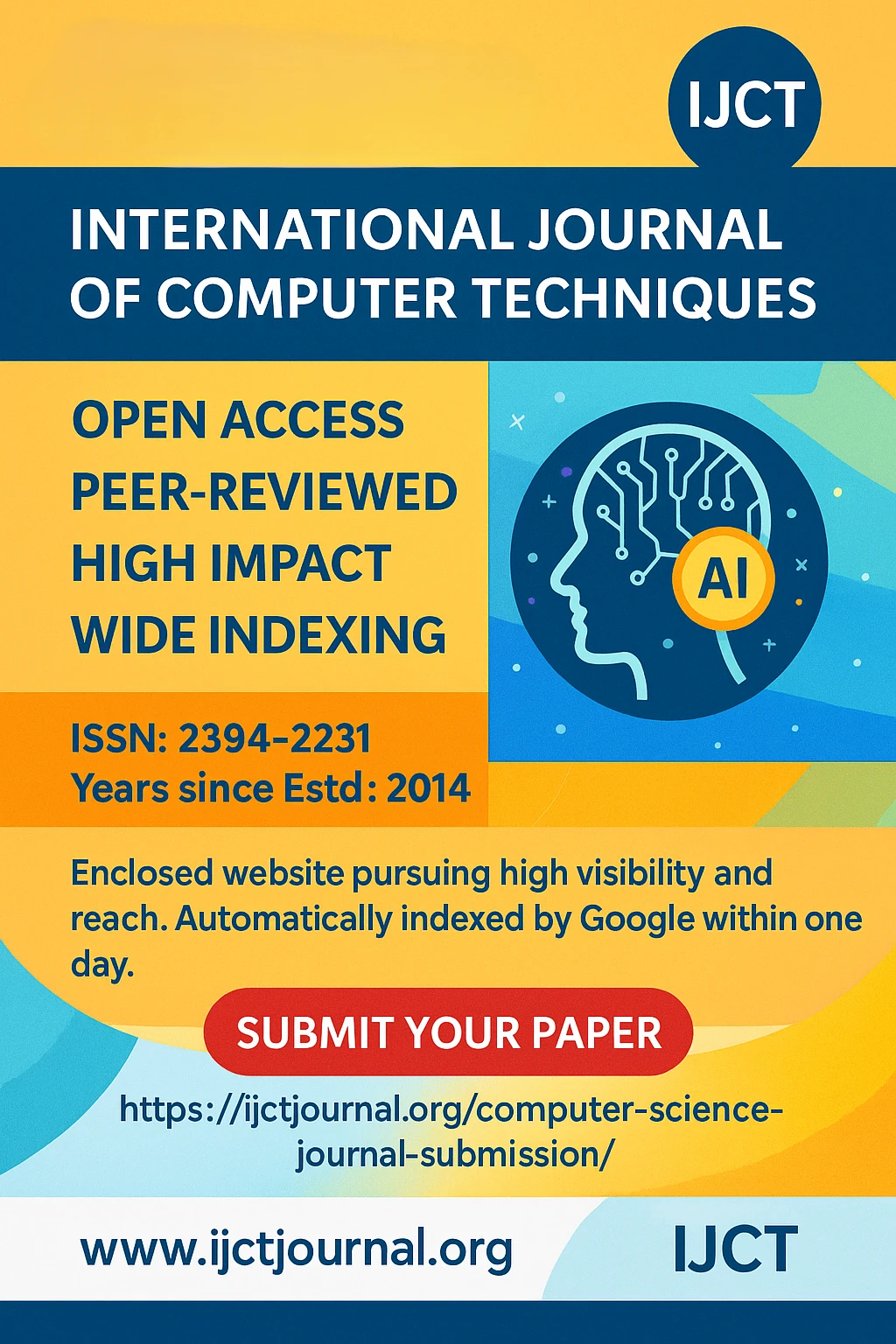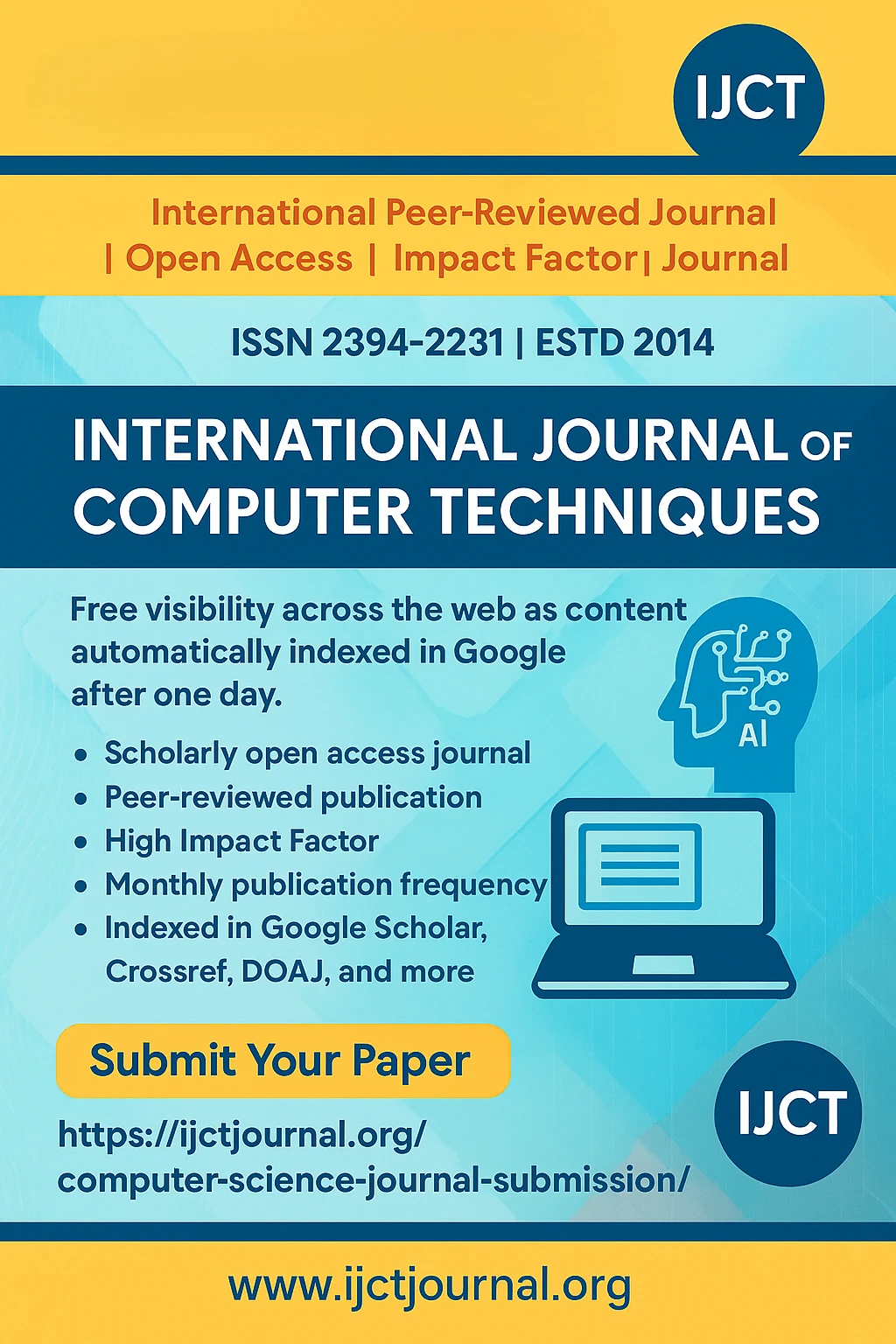
A Hybrid Deep Learning System for Automatic Music Genre Classification | IJCT Volume 12 – Issue 5 | IJCT-V12I5P69

International Journal of Computer Techniques
ISSN 2394-2231
Volume 12, Issue 5 | Published: September – October 2025
Author
Adebanjo, Adedoyin S., Odesanya, Konyisola A., Bello, Sheriff K., Oyerinde Emmanuel , Adeoti Babajide Ebenezer, Mgbeahuruike Emmanuel
Table of Contents
ToggleAbstract
The rapid growth of digital music libraries has made manual genre classification inefficient and inconsistent. This study proposes an automatic music genre classification system using a hybrid deep learning model. The model combines Convolutional Neural Networks (CNNs) for feature extraction and Recurrent Neural Networks (RNNs) for recognizing sequential patterns. It uses Mel-spectrograms and MFCCs extracted with Librosa from a Kaggle dataset of 10 genres. The implementation is done with Python, TensorFlow, Keras, and the system is deployed via Streamlit for real-time predictions. Experimental results show a classification accuracy of 90%. This outperforms standalone models by 3% and demonstrates the system’s effectiveness, scalability, and potential to improve music recommendation and retrieval platforms.
Keywords
Audio Feature Extraction, CNN-RNN Hybrid Model, Deep Learning,Music Information Retreieval, Music Genre Classification.Conclusion
This study explored the potential of deep learning models in accurately identifying different music genres. The study implemented three distinct architectures: Convolutional Neural Networks (CNN), Recurrent Neural Networks (RNN), and a hybrid CNN-RNN model. Through extensive data preprocessing, including noise reduction, feature extraction, and augmentation, the system was optimized for high performance. The results demonstrated that the hybrid CNN-RNN model provided the best accuracy, effectively capturing both spatial and temporal dependencies in music signals. By leveraging CNNs and RNNs, the system effectively classified music genres with high accuracy, demonstrating the effectiveness of combining spatial and temporal feature extraction techniques. The findings confirm that deep learning approaches can significantly improve automated music classification, with implications for applications in streaming services, recommendation systems, and digital music libraries.
References
Statista, “Number of paying YouTube Music and YouTube Premium subscribers worldwide from 2020 to 2024,” 2024. [Online]. Available: https://www.statista.com/statistics/1344265/youtube-paying-subscribers/.
[2] Statista, “Average daily time spent streaming music on Spotify and Apple Music among internet users worldwide as of the 4th quarter of 2018, by region,” 2024. [Online]. Available: https://www.statista.com/statistics/1100724/time-spent-streaming-music-by-region/.
[3] Statista, “Music streaming – Nigeria,” 2024. [Online]. Available: https://www.statista.com/outlook/dmo/digital-media/digital-music/music-streaming/nigeria/.
[4] J. S. Downie, D. Byrd, and T. Crawford, “Ten years of ISMIR: Reflections on challenges and opportunities,” in Proc. 10th Int. Soc. Music Inf. Retrieval Conf., Kobe, Japan, 2009, pp. 13–18.
[5] C. Palisca, “Marc Scacchi’s defense of new music,” Muzyka, vol. 43, pp. 131–132, 1998.
[6] A. North and D. Hargreaves, The Social and Applied Psychology of Music. Oxford, U.K.: Oxford Univ. Press, 2008.
[7] G. Sun, “Research on architecture for long-tailed genre computer intelligent classification with music information retrieval and deep learning,” J. Phys.: Conf. Ser., vol. 2033, p. 012008, 2021.
[8] W. Wang, Y. Huang, Y. Wang, and L. Wang, “Generalized autoencoder: A neural network framework for dimensionality reduction,” in Proc. IEEE Conf. Comput. Vis. Pattern Recognit. Workshops (CVPRW), 2014, pp. 490–497.
[9] A. Dorochowicz, A. Kurowski, and B. Kostek, “Employing subjective tests and deep learning for discovering the relationship between personality types and preferred music genres,” Electronics, vol. 9, no. 12, p. 2016, 2020. [Online]. Available: https://doi.org/10.3390/electronics9122016.
[10] Y. Zhang and T. Li, “Music genre classification with parallel convolutional neural networks and capuchin search algorithm,” Sci. Rep., vol. 15, p. 9580, 2025. [Online]. Available: https://doi.org/10.1038/s41598-025-90619-7.
[11] L. Liu, “The implementation of a proposed deep-learning algorithm to classify music genres,” Open Comput. Sci., vol. 14, no. 1, p. 20230106, 2024. [Online]. Available: https://doi.org/10.1515/comp-2023-0106.
[12] N. Ndou, R. Ajoodha, and A. Jadhav, “Music genre classification: A review of deep-learning and traditional machine-learning approaches,” in Proc. 2021 IEEE Int. IoT, Electron. and Mechatronics Conf. (IEMTRONICS), 2021, pp. 1–6. doi: 10.1109/IEMTRONICS52119.2021.9422487.
[13] M. Ashraf, F. Abid, I. U. Din, J. Rasheed, M. Yesiltepe, S. F. Yeo, and M. T. Ersoy, “A hybrid CNN and RNN variant model for music classification,” Applied Sciences, vol. 13, no. 3, p. 1476, 2023. doi: 10.3390/app13031476.
[14] H. Foroughmand and G. Peeters, “Extending deep rhythm for tempo and genre estimation using complex convolutions, multitask learning and multi-input network,” in Proc. 2020 Joint Conf. AI Music Creativity, Stockholm, Sweden, Oct. 2020. [Online]. Available: https://hal.science/hal-03127155.
[15] M. Schedl, E. Gómez, and J. Urbano, Music Information Retrieval: Recent Developments and Applications. Boston, MA, USA: Now Publishers, 2014. [Online]. Available: https://doi.org/10.1561/1500000042.
[16] K. Choi, G. Fazekas, M. B. Sandler, and K. Cho, “Convolutional recurrent neural networks for music classification,” arXiv preprint arXiv:1609.04243, 2016. [Online]. Available: https://doi.org/10.48550/arXiv.1609.04243.
[17] L. Qiu, S. Li, and Y. Sung, “DBTMPE: Deep bidirectional transformers-based masked predictive encoder approach for music genre classification,” Mathematics, vol. 9, no. 5, p. 530, 2021. [Online]. Available: https://doi.org/10.3390/math9050530.
[18] Y. Tian, “Deep neural networks and fractional grey lag goose optimization for music genre identification,” Sci. Rep., vol. 15, p. 6702, 2025. [Online]. Available: https://doi.org/10.1038/s41598-025-91203-9.
[19] Y. Ding, H. Zhang, W. Huang, X. Zhou, and Z. Shi, “Efficient music genre recognition using ECAS-CNN: A novel channel-aware neural network architecture,” Sensors, vol. 24, no. 21, p. 7021, 2024. [Online]. Available: https://doi.org/10.3390/s24217021.
[20] M. K. Kumar, K. Sujanasri, B. Neha, G. Akshara, P. Chugh, and P. Haindavi, “Automated music genre classification through deep learning techniques,” E3S Web Conf., vol. 430, p. 01033, 2023. [Online]. Available: https://doi.org/10.1051/e3sconf/202343001033.
[21] L. Alzubaidi, J. Zhang, A. J. Humaidi, A. Al-Dujaili, Y. Duan, O. Al-Shamma, J. Santamaría, M. A. Fadhel, M. Al-Amidie, and L. Farhan, “Review of deep learning: Concepts, CNN architectures, challenges, applications, future directions,” J. Big Data, vol. 8, p. 53, 2021. [Online]. Available: https://doi.org/10.1186/s40537-021-00444-8.
[22] Y.-J. Mon, “LSTM-based music generation technologies,” Computers, vol. 14, no. 6, p. 229, 2025. [Online]. Available: https://doi.org/10.3390/computers14060229.
[23] G. Tzanetakis and P. Cook, “Musical genre classification of audio signals,” IEEE Trans. Speech Audio Process., vol. 10, no. 5, pp. 293–302, Jul. 2002. doi: 10.1109/TSA.2002.800560.
[24] J. Perianez-Pascual, J. D. Gutiérrez, L. Escobar-Encinas, Á. Rubio-Largo, and R. Rodriguez-Echeverria, “Beyond spectrograms: Rethinking audio classification from EnCodec’s latent space,” Algorithms, vol. 18, no. 2, p. 108, 2025. [Online]. Available: https://doi.org/10.3390/a18020108.
Journal Covers
IJCT Important Links
© 2025 International Journal of Computer Techniques (IJCT).











